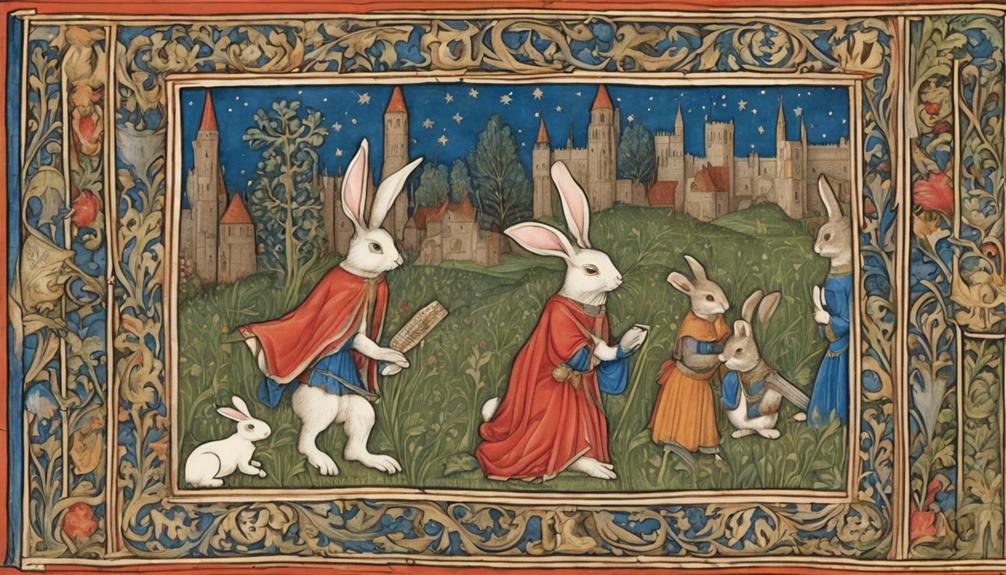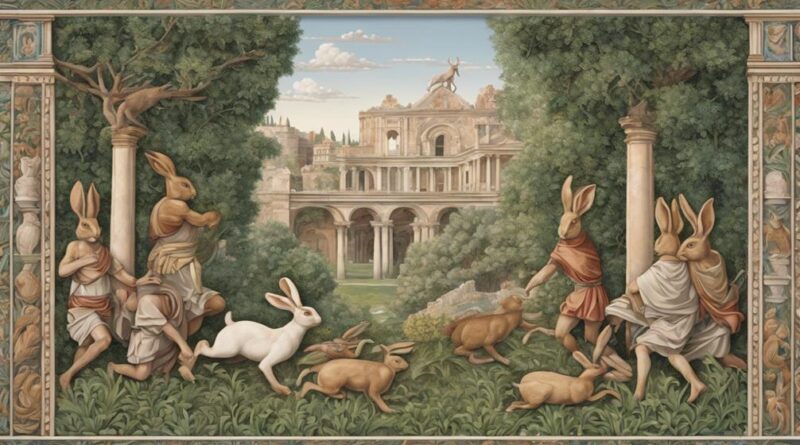7 Instances of Rabbits in Ancient Art and Literature
In ancient art and literature, rabbits symbolized diverse meanings across cultures. Egyptian hieroglyphs linked them to concepts of existence and renewal. Greek mythology portrayed rabbits as symbols of fertility and vitality. Chinese and Indian cultures associated rabbits with good fortune, longevity, and moral virtues like perseverance. Mesoamerican rituals showcased rabbits as divine intermediaries, while Roman literature admired them for cleverness and agility. From Chinese paintings to European manuscripts, rabbits appeared as auspicious beings representing harmony, fertility, and innocence. These depictions unveil a world where rabbits embody more than meets the eye, revealing layers of symbolism waiting to be discovered.
Rabbits Depicted in Ancient Egyptian Hieroglyphs
Rabbits frequently featured in Ancient Egyptian hieroglyphs, symbolizing fertility, agility, and rebirth. The hieroglyphic interpretations of rabbits in Ancient Egypt held deep cultural significance. The rabbit hieroglyph was often used to represent the concept of 'to be' or 'to exist,' signifying the idea of regeneration and renewal. This association with fertility and rebirth stemmed from the rabbit's prolific breeding habits and its ability to swiftly multiply, linking it to the cycle of life and death in Egyptian beliefs.
Moreover, the agility of rabbits was also a key aspect of their representation in hieroglyphs. The quick movements and nimbleness of rabbits were admired traits that the Egyptians sought to embody in their daily lives. By incorporating the rabbit symbol into their written language, the Egyptians not only paid homage to these physical attributes but also imbued their written communication with a sense of vitality and dynamism.
In essence, the inclusion of rabbits in Ancient Egyptian hieroglyphs went beyond simple depictions of an animal; it delved into the realms of symbolism and cultural values. The hieroglyphic interpretations of rabbits as symbols of fertility, agility, and rebirth highlight the profound connection between nature, language, and spirituality in ancient Egyptian society.
Rabbit Symbolism in Ancient Greek Mythology
Symbolizing various aspects of nature and fertility in Ancient Greek mythology, rabbits played significant roles in the narratives of gods and heroes. In Greek mythology, the rabbit symbolized fertility and the cycle of life due to their reputation for prolific breeding. The association of rabbits with fertility was prominently featured in the tales of the goddess of agriculture, Demeter, and her daughter Persephone. In the myth of Persephone's abduction by Hades, it's said that the goddess transformed a nymph into a rabbit as a punishment for revealing her secret. This transformation emphasized the rabbit's connection to fertility and the cycles of life and death.
Moreover, rabbits were also linked to the trickster archetype in Greek mythology. The rabbit's quickness and elusiveness made it a fitting symbol for characters known for their cunning and cleverness. The trickster figure was often portrayed as outwitting others through their intelligence and resourcefulness, traits that the rabbit embodied through its ability to escape predators with agility and speed.
Rabbits in Chinese Ancient Paintings
In the realm of Chinese ancient paintings, depictions of rabbits hold a significant place, showcasing intricate symbolism and cultural significance. Rabbits in Chinese art are often seen as symbols of good fortune, longevity, and fertility. One folklore interpretation that's commonly associated with rabbits in Chinese culture is the story of the Moon Goddess Chang'e and her companion, the Jade Rabbit. This mythological tale highlights the rabbit's connection to the moon and its representation of immortality and divine powers.
The cultural significance of rabbits in Chinese ancient paintings goes beyond mere symbolism. Rabbits are frequently portrayed in various settings, such as gardens or celestial realms, emphasizing their role as auspicious creatures. The meticulous details in these paintings convey a sense of harmony with nature and the spiritual world. Artists often use rabbits to evoke feelings of abundance, prosperity, and happiness, making them popular motifs in traditional Chinese art.
Furthermore, rabbits in Chinese ancient paintings aren't only admired for their aesthetic appeal but also revered for their deeper meanings. The presence of rabbits in these artworks reflects the deep-rooted beliefs and values of Chinese society, where these animals are regarded as harbingers of positivity and blessings. Overall, the portrayal of rabbits in Chinese ancient paintings serves as a profound reflection of the cultural heritage and spiritual richness of the Chinese civilization.
Rabbits in Mesoamerican Codices
The intricate portrayal of cultural symbolism and significance in Chinese ancient paintings transitions seamlessly into exploring the representation of rabbits in Mesoamerican Codices, shedding light on another fascinating aspect of animal imagery in ancient art.
- Rabbit role in Mesoamerican rituals: Mesoamerican Codices depict rabbits as significant beings involved in various rituals and ceremonies. These illustrations often show rabbits alongside priests, symbolizing their active participation in religious practices. The rabbits' presence in these rituals hints at their perceived spiritual importance in Mesoamerican society.
- Rabbit significance in Indigenous beliefs: Within Mesoamerican Codices, rabbits hold a special place in Indigenous beliefs. They're often portrayed in conjunction with deities or supernatural entities, signifying their connection to the spiritual realm. The rabbits' role as intermediaries between humans and the divine is highlighted through their frequent appearance in these sacred texts.
- Artistic representation of rabbits: In Mesoamerican Codices, the artistic depiction of rabbits goes beyond mere physical resemblance. The intricate details and symbolic elements surrounding the rabbits in these artworks reveal a deeper layer of meaning. Through their posture, facial expressions, and accompanying symbols, rabbits in Mesoamerican Codices convey complex narratives and cultural significance that enrich our understanding of Indigenous beliefs and practices.
Rabbit Motifs in Ancient Indian Texts
Ancient Indian Texts intricately weave rabbit motifs into their narratives, offering profound insights into cultural symbolism and spiritual themes. Rabbits hold significant symbolism in ancient Indian culture, representing various attributes such as fertility, abundance, and agility. In Hindu mythology, the moon is often depicted as being chased by a rabbit, symbolizing the endless cycle of time and the connection between the lunar cycles and fertility. This motif highlights the rabbit's role as a symbol of renewal and regeneration in the cosmic order.
Furthermore, the rabbit is also associated with the concept of sacrifice and altruism in Indian texts. The story of the rabbit in the Jataka tales, where the selfless rabbit offers itself as a meal to a hungry beggar who's actually a divine entity in disguise, illustrates the cultural significance of compassion and selflessness. This narrative underscores the value placed on acts of kindness and generosity in ancient Indian society.
In addition to its symbolic meanings, the rabbit motif in ancient Indian texts serves as a metaphor for humility and perseverance. The rabbit's ability to outsmart larger predators through its cunning and quick thinking is often highlighted as a lesson in resourcefulness and intelligence. Overall, the rabbit holds a multifaceted role in ancient Indian literature, embodying diverse cultural significances that resonate with spiritual and moral themes.
Ancient Roman Literature Featuring Rabbits
Rabbits feature prominently in the literary works of ancient Rome, showcasing a blend of symbolism and cultural significance. Ancient Roman literature often used rabbits symbolically, drawing on the animals' characteristics to convey deeper meanings.
Here are three ways in which Roman rabbit symbolism and ancient rabbit folklore were intertwined in their literature:
- Fertility and Rebirth: In Roman mythology, rabbits were associated with fertility and rebirth due to their prolific breeding habits. Writers often used rabbits as symbols of new beginnings, growth, and the cyclical nature of life.
- Cleverness and Deception: The cleverness and agility of rabbits were also prevalent themes in Roman literature. Just like in Aesop's fables, where the clever rabbit outwits larger animals, Roman writers used rabbits to represent cunning, intelligence, and sometimes deception.
- Speed and Agility: Rabbits were admired for their speed and agility, traits that were highly valued in Roman society. These characteristics were often attributed to characters in Roman literature who needed to navigate challenges with quick thinking and nimbleness.
Through these symbolic representations, rabbits became integral to the tapestry of ancient Roman storytelling, adding layers of meaning and cultural context to the narratives of the time.
Rabbits in Medieval European Illuminated Manuscripts

Exploring the intricate depictions found in Medieval European illuminated manuscripts reveals a fascinating narrative surrounding the presence and symbolism of rabbits in this artistic tradition. In these manuscripts, rabbits are often depicted in a variety of contexts, showcasing the significance and versatility of these creatures in medieval art.
Rabbits in Medieval European illuminated manuscripts weren't only decorative elements but also held symbolic meanings. They were commonly associated with concepts like fertility, abundance, and even innocence. The intricate details in these illustrations, often created using elaborate Illuminated manuscripts techniques, showcase the high level of craftsmanship and skill possessed by medieval artists.
In addition to their symbolic significance, rabbits in these manuscripts were also sometimes depicted in scenes reminiscent of medieval tapestries. These illustrations often portrayed rabbits in lush, pastoral settings, surrounded by vibrant flora and fauna. The use of vibrant colors and intricate patterns in these depictions further highlights the artistry and attention to detail present in medieval illuminated manuscripts.
Frequently Asked Questions
Were Rabbits Considered Sacred Animals in Any Ancient Civilizations?
In some ancient civilizations, rabbits were indeed considered sacred animals.
For example, in Ancient Egypt, rabbits were symbolic of fertility and rebirth. Additionally, in the Aztec civilization, rabbit deities played a significant role in their religious beliefs.
These animals were revered for their connection to procreation and the cycle of life.
This reverence highlights the importance of rabbits in ancient cultures and their spiritual significance.
How Did the Portrayal of Rabbits Differ in Various Ancient Art Forms?
In ancient art, the portrayal of rabbits varied greatly, reflecting diverse cultural beliefs and symbolism. From symbolizing fertility and rebirth to representing cunning and cleverness, rabbits held different meanings across civilizations.
Their presence in art often mirrored the cultural significance attributed to them, showcasing the intricate relationship between animals and human interpretation in ancient societies.
This exploration of symbolism in ancient art offers insights into the varying perspectives on rabbits throughout history.
Did Ancient Cultures Have Specific Beliefs Regarding Rabbit Behavior?
Ancient beliefs about rabbits varied widely, with many cultures attributing symbolism to these creatures. In some societies, rabbits were seen as symbols of fertility and abundance, while in others they were associated with trickery and cunning.
Rabbit symbolism often reflected the values and beliefs of the people, showcasing a mix of positive and negative traits. Understanding these ancient beliefs can provide insight into the cultural significance of rabbits in various civilizations.
Were There Any Superstitions Associated With Rabbits in Ancient Times?
In ancient times, rabbits were often associated with various superstitions and symbolic meanings. Folklore beliefs attributed to these creatures included notions of fertility, abundance, and luck. Rabbits held cultural significance in many societies, symbolizing agility, cleverness, and quickness.
Superstitions surrounding rabbits ranged from being omens of good fortune to symbols of deceit and trickery. Understanding these beliefs provides insight into the diverse perspectives ancient cultures held towards these animals.
Did Rabbits Play a Role in Any Ancient Religious Ceremonies or Rituals?
In ancient times, rabbits held significant ritual symbolism and cultural significance in various religious ceremonies. Their presence often represented fertility, abundance, and rebirth in many cultures. Associated with deities linked to spring and renewal, rabbits were incorporated into rituals to ensure agricultural prosperity and the cycle of life.
Their swift reproductive nature also symbolized the cyclical nature of existence, making them a common motif in religious practices across ancient civilizations.
Conclusion
In conclusion, the presence of rabbits in ancient art and literature across various cultures highlights the enduring significance of these creatures throughout history.
From Egyptian hieroglyphs to Greek mythology, Chinese paintings to Mesoamerican codices, rabbits have symbolized fertility, rebirth, and agility.
Their portrayal in ancient texts and manuscripts reflects the cultural beliefs and values of different civilizations, offering insights into the diverse ways in which rabbits have been perceived and revered over the centuries.
